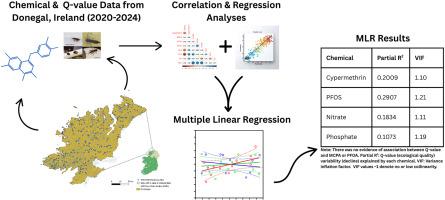确定有机化学物质和营养物质对河流生态质量的影响:爱尔兰多尼戈尔的案例研究。
IF 7.3
2区 环境科学与生态学
Q1 ENVIRONMENTAL SCIENCES
引用次数: 0
摘要
一项被称为q值的底栖大型无脊椎动物指标显示,自2004年开始进行生物监测以来,爱尔兰多尼戈尔河流的生态质量有所下降。以前的研究表明,杀虫剂氯氰菊酯可能是一个驱动因素。自2020年开始危险化学品监测以来,多尼戈尔的河流中经常检测到氯氰菊酯和其他三种有机化学品(MCPA、全氟辛酸和全氟辛烷磺酸)。研究人员分析了2020年至2024年间来自多尼戈尔15个河流站点的有机化学物质和营养物质的现有监测数据,以q值作为生态质量的替代品,估计它们对河流生态质量的相对影响。氯氰菊酯、MCPA和磷酸盐含量超过相关环境标准的约为10-30%,全氟辛烷磺酸、全氟辛烷磺酸和硝酸盐含量低于相关环境标准。双变量分析表明,q值与氯氰菊酯、全氟辛烷磺酸和营养物质呈负相关,与MCPA和PFOA无显著相关。多变量模型证实,氯氰菊酯可能是多尼戈尔河流生态退化的重要驱动因素,解释了大约20%的q值趋势(部分R平方,pR2: 0.2009)。全氟辛烷磺酸(pR2: 0.2907)、硝酸盐(pR2: 0.1834)和磷酸盐(pR2: 0.1073)也解释了q值的变化趋势。我们的结果基于多尼戈尔15个(约4%)河流采样点的约1,500个数据点。然而,他们建议需要:1)更好地协调生物和化学监测计划;2)评估相对低浓度化学物质的生态影响;3)进一步减少营养物和PFAS对地表水的污染。未来的研究建议使用来自爱尔兰或其他具有类似监测计划的国家的更大的数据集。本文章由计算机程序翻译,如有差异,请以英文原文为准。

Determining the impact of organic chemicals and nutrients on river ecological quality: a case study from Donegal, Ireland.
A benthic macroinvertebrate indicator known as Q-value shows that the ecological quality of rivers in Donegal, Ireland has declined since biological monitoring began in 2004. Previous studies suggested that the insecticide cypermethrin may be a driving factor. Cypermethrin and three other organic chemicals (MCPA, PFOA and PFOS) have been frequently detected in rivers in Donegal since hazardous chemical monitoring started in 2020. Available monitoring data on those organic chemicals and nutrients, from 15 river sites in Donegal between 2020 and 2024, were analysed to estimate their relative impact on river ecological quality, using Q-values as surrogate of ecological quality. Around 10-30% of cypermethrin, MCPA and phosphate levels were above relevant environmental standards, while PFOA, PFOS and nitrate levels were below. Bivariate analyses showed negative relationships of Q-value with cypermethrin, PFOS and nutrients but not with MCPA or PFOA. Multivariate models confirmed that cypermethrin may be an important driver of ecological decline in Donegal rivers, explaining around 20% of the Q-value trends (partial R squared, pR2: 0.2009). Q-value trends were also explained by PFOS (pR2: 0.2907), nitrate (pR2: 0.1834) and phosphate (pR2: 0.1073). Our results are based on approximately 1,500 datapoints from 15 (∼4%) river sampling sites in Donegal. However, they suggest the need to: 1) better align biological and chemical monitoring programmes; 2) assess the ecological impact of chemicals even at relatively low concentrations, and 3) further reduce surface water pollution from nutrients and PFAS. Future studies are recommended using larger datasets from Ireland or other countries with similar monitoring programmes.
求助全文
通过发布文献求助,成功后即可免费获取论文全文。
去求助
来源期刊

Environmental Pollution
环境科学-环境科学
CiteScore
16.00
自引率
6.70%
发文量
2082
审稿时长
2.9 months
期刊介绍:
Environmental Pollution is an international peer-reviewed journal that publishes high-quality research papers and review articles covering all aspects of environmental pollution and its impacts on ecosystems and human health.
Subject areas include, but are not limited to:
• Sources and occurrences of pollutants that are clearly defined and measured in environmental compartments, food and food-related items, and human bodies;
• Interlinks between contaminant exposure and biological, ecological, and human health effects, including those of climate change;
• Contaminants of emerging concerns (including but not limited to antibiotic resistant microorganisms or genes, microplastics/nanoplastics, electronic wastes, light, and noise) and/or their biological, ecological, or human health effects;
• Laboratory and field studies on the remediation/mitigation of environmental pollution via new techniques and with clear links to biological, ecological, or human health effects;
• Modeling of pollution processes, patterns, or trends that is of clear environmental and/or human health interest;
• New techniques that measure and examine environmental occurrences, transport, behavior, and effects of pollutants within the environment or the laboratory, provided that they can be clearly used to address problems within regional or global environmental compartments.
 求助内容:
求助内容: 应助结果提醒方式:
应助结果提醒方式:


